The ancient art of Gyotaku, or fish rubbing, dates back to the mid-1800s. In order to record their catches, fishermen “printed” the fish they caught on paper. By coating both sides of a fish in ink and pressing it between folded pieces of paper, the fisherman could capture a picture-perfect image of both sides of the fish.
No longer needed as a recording tool, Gyotaku has since become an art form unto itself. The technique captures the delicate details of a variety of natural objects like leaves and flowers. In some cases, artists will simply supplement the ink printings with additional hand drawings and color. In other cases, students create a repeating pattern using the same object. As the saturation and ink color fades with multiple uses, the artist fills the color in by hand.
We’ve put a modern spin on this age-old printing technique. The free Iridescent Ocean Textiles Prints art lesson uses Gyotaku fish print models, fabric inks, and metallic paint pigments to create spectacular, shimmering prints that can be matted and mounted as masterpieces. Students coat a roller in ink, roll their object with the roller, and press paper down on top of the object. After that, they’ll use repeats, patterns, and additional colors with shimmering dust and powders to personalize their work.
Iridescent Ocean Textile Prints Lesson Plans
Follow the link above for the Iridescent Ocean Textile Prints art lesson plan, including images, step-by-step directions, and a materials list. Suitable for grades 3-12.
What other objects could be made into art using Gyotako? Share your ideas in the comments below!






Leave a Reply